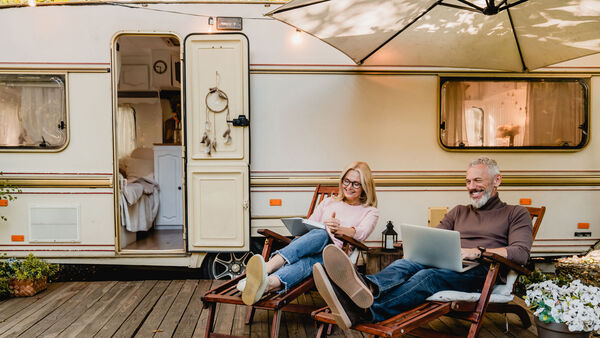Hardly anyone wants to do without stable Internet reception - even at the campsite. LTE antennas enable surfing on the move even in remote regions, but at a hefty price.
Smartphone, tablet, laptop and smart TV - they're all only worth half as much without a stable Internet connection. Googling, planning excursions or streaming a crime thriller via Netflix in the evening - all this only works if the reception is good. However, WLAN networks at campsites are often so overloaded, especially in the evening, that streaming in particular is hardly possible. And smartphones also often reach their limits with their reception in remote areas.
Special systems consisting of an antenna and router aim to close this gap. They optimize the LTE signal and - since they are usually mounted on the caravan roof - have the advantage over the smartphone that reception is not disturbed by the vehicle's aluminum body. The well-known suppliers Alphatronics, Ten Haaft, Maxview, WiCAR and Travel Vision offer such systems especially for campers. They combine powerful LTE antennas with a Wi-Fi antenna so that the camper can get the Internet into the vehicle both via mobile communications and - if available - also via an existing Wi-Fi network. Such MIMO antennas (Multiple Input, Multiple Output) use several transmitting and receiving elements, and GPS reception is usually included as well. They therefore send and receive the data stream via several antennas at the same time. But be careful: In order to guarantee the best possible reception in heavily used WLAN networks, the system should ideally be equipped with several WLAN modules, such as the Oyster Connect from Ten Haaft. Three chips, one in the outdoor unit and two in the indoor unit, guarantee a seamless data flow - depending on the individual requirements of the end devices. But that costs money, too.
The antennas transmit the received signal to the router inside the vehicle via a data or coaxial cable. The cables should be as short as possible, since the quality loss per meter of cable is very high. The router in turn sets up a WLAN network that all end devices such as smartphones, tablets or notebooks can dial into.
A SIM card is also required to use the LTE antenna, which is not included in the packages. Those who already have a cell phone contract with a secondary card can use it. In most European countries, roaming charges have been abolished since 2017 - nevertheless, travelers should check before departure whether the data volume for abroad is limited and adjust this if necessary. Those planning a longer tour in a country can also purchase a SIM card locally - prepaid cards are particularly suitable in this case and ensure that costs remain manageable. In most European countries, data rates are much cheaper than in Germany anyway.
If you are confident enough, you can install the antennas yourself - cables, mounting brackets and operating instructions are included in the packages. However, a roof duct is required for the connection between the antenna and the router. This must be properly installed and sealed, which is usually the responsibility of a specialist workshop.
The systems currently cost between 600 and 1,000 euros. In addition, there are the fees for the SIM card and possibly costs for data. Those who want to stream series and movies via Netflix, Amazon Prime & Co. must also reckon with monthly subscription costs of around ten euros.
ATTB WiCAR
The company Antennentechnik Bad Blankenburg (ATTB) is launching WiCAR, a small, compact LTE router that, in combination with powerful antennas, enables Internet access via Wifi or LAN cable, mobile working and extensive infotainment, as well as access to the home network and GPS route tracking. Depending on the model, the hardware box has a wide range of connections and is quick and easy to install. The MyWiCAR portal offers users a wide range of planning and configuration options. For campers, ATTB recommends the router models 9004.02, 9009.02 and 9009.03, which are priced between 454.80 and 858.90 euros in combination with an LTE antenna and an indoor antenna for Wifi reception. They differ in the range of their functions and connections. With the LTE antenna, the customer also has the choice between an outdoor (roof) and a window antenna. Those who want the best possible reception should opt for a roof antenna. A window antenna can be an alternative if the space on the roof is already occupied or the customer does not want a roof duct for the RF coaxial cable between the antenna and router. According to ATTB, however, a disk antenna cannot match the performance of a roof antenna. https://www.attb.de/en/wicar


Follow us